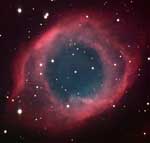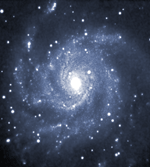I have been told that I have to describe my equipment and techniques. I used a Meade 10" LX200-GPS telescope for all of these images. I used three different camera systems. All of the false-color deep-sky objects were taken using an Apogee Alta 512 x 512 pixel (20 micron pixel size) camera without any filters. Most of the deepsky images are stacks of 20, 40, or 80 snapshots taken at 20 s exposure each. Short exposures are necessary because the telescope has no equatorial wedge, so the field rotates. For the same reason, the images are unguided. The images are registered and combined using Maxim DL, and wavelet enhanced in Registax 2. I scaled the intensity on a logarithmic scale using IDL. Final adjustment was done in Photoshop.
I have recently (2005 May 05) received a new SBIG STL-1301 CCD camera with LRGB filters, and have been experimenting with true-color imaging. My experiments are shown in the top table above. This camera is 1280 x 1024 pixels, 16 mm pixels.
All of the images in the solar system section were taken with a Toucam Pro II webcam, registered and enhanced in Registax 2, and further enhanced (usually just background and contrast were adjusted) in Photoshop. To image the Moon (at right), the webcam was running while I slewed around the face of the Moon to cover it entirely, holding for about 1 second on each new field. I then created single images in Registax 2 using snippets of the video clipped out with VirtualDub. This is a truly amazing piece of free software that you WILL want if you use a webcam for capturing video. Finally, I assembled the mosaic in Photoshop, laboriously adjusting the contrast to avoid brightness edges--very tedious! |
|


|







































































































